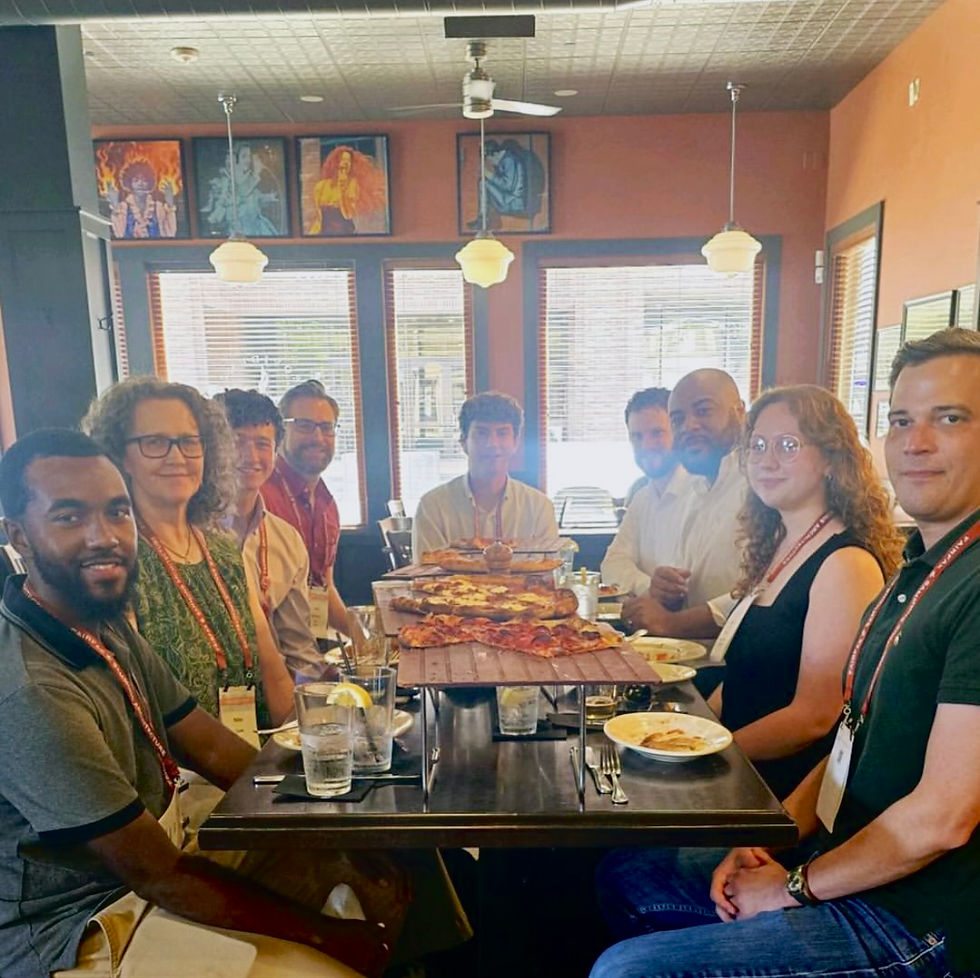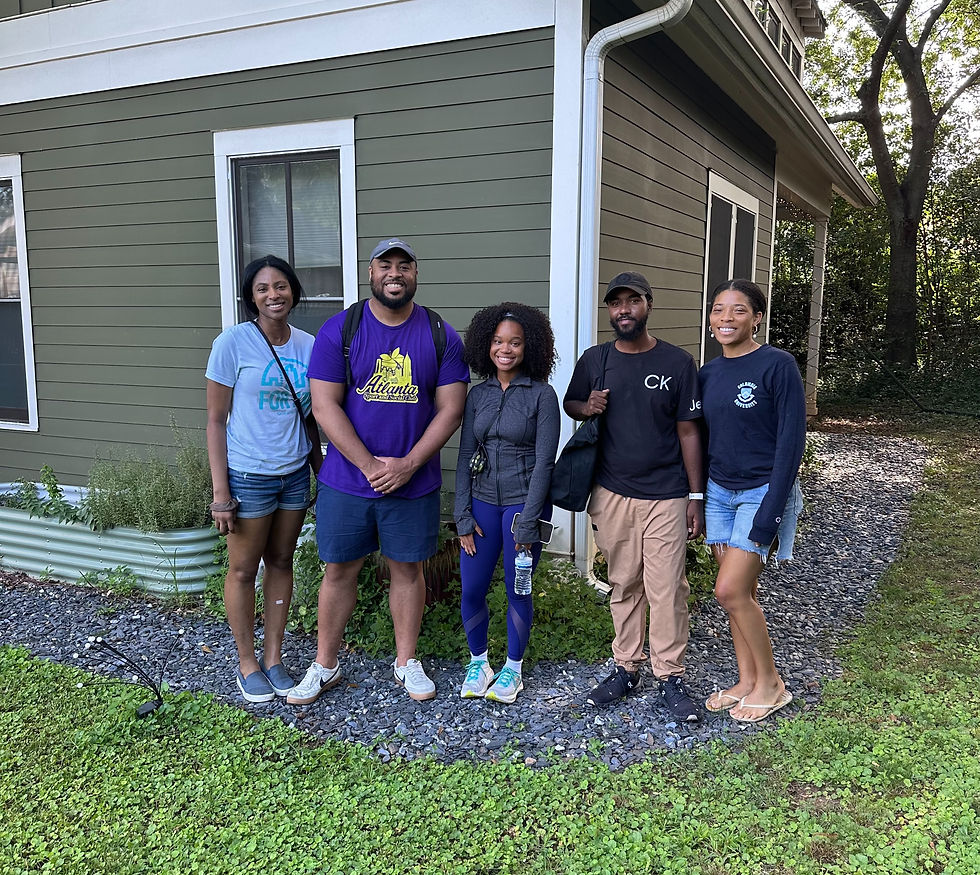Q&A with Nick Mulkey and Vanessa Ibarra with CNU Atlanta
- David Melton
- Sep 2
- 6 min read

1. Tell us about yourselves and your roles in City of Atlanta and CNU
Nick: I’m a civil servant and have worked in economic development for over a decade at the city, state, and now international level. I’ve always been interested in cities. As a kid I played SimCity and other city-building games for hours, which sparked a natural curiosity in urban development and design. That interest turned into a career in public policy and city building, and I’ve been in it ever since. I now work in international affairs focusing on business initiatives and global commerce. I'm also the president of the Congress for the New Urbanism Atlanta chapter, where I work to champion urbanism throughout Atlanta and the South.
Vanessa: I have a master’s in international business and have worked with foreign governments, supporting the French on green building and civilian safety, consulting in Germany, and I've advised three Atlanta mayors over the last decade in the Mayor’s Office of International and Immigrant Affairs. That’s how I met Nick when he was at Invest Atlanta—we started dreaming about what the city could look like. I stepped down a year and a half ago to spend more time with my son, then founded The Shared World, a global/local advisory firm focused on smart cities, social initiatives, and entrepreneurship. I serve as the Advance Lead for CNU Atlanta, identifying partnerships and projects to engage young professionals and students and help CNU Atlanta grow.
2. What is New Urbanism?
Nick: New Urbanism really sprouted after the work of Jane Jacobs—this idea that cities can and should be built for people. That they should be walkable, livable, and full of vibrant public spaces. These things are critical to quality of life. For me, the solution to most of our challenges starts with how we’ve built our communities. Look at public health—when we don’t walk, we have higher rates of diabetes and cancer. Or economic opportunity—if someone in low-income housing can’t get to a job on the other side of town without a car, that’s a broken model. But if we built more efficiently, they could walk or take transit. That’s why I care about this—it’s about building better for everyone, especially here in the South where past decisions have created real barriers.
3. What is the Congress for the New Urbanism?
Vanessa: The Congress for the New Urbanism (CNU) is a national nonprofit that promotes walkable, people-centered, and equitable urban design. It's made up of architects, planners, developers, civic leaders, and everyday citizens who believe better urban design can lead to stronger communities and better lives. CNU Atlanta is the local chapter focused on bringing these ideas to life in the region. We host events, support student and professional engagement, and launch initiatives that pair local and global planning projects with Atlanta’s urbanists and designers. I think it’s important to empower organizations like CNU because they represent the future generation of talent and leadership.

4. How does Atlanta compare to other cities from an urbanist's perspective?
Nick: Honestly, I think we’ve got a 5 to 10-year window to get it right, or we’ll miss the mark and become a passerby city. I’m always texting Vanessa saying, “Look what Chicago or New York is doing.” What really concerns me are the Midwest and Rust Belt cities. They already have walkable frameworks that are far ahead of Atlanta’s. If they reinvest in housing and infrastructure, and some already are, it’ll be tough for us to compete, especially as climate change makes their winters milder. Chicago hasn’t had a severe winter in the last 3-4 years. If they pair that with strong walkability and job access, we’ll lose talent to them. I don’t want to leave Atlanta, but if we don’t get this right, people will find better urban experiences elsewhere.
5. What can Atlanta do over the next 5-10 years to get it right?
Vanessa: I think we need to engage the community more. If the public is behind you, it’s easier for the city to take bold steps. Pilot projects and activations like bike lanes and Atlanta Streets Alive, for example, help show that the interest is there. We also need to find new funding. Everyone looks to the city to pay for things, but we need more external partners to step in. And we can’t forget preservation. Here in Sweet Auburn alone, 55% of the buildings that once stood are gone. Preserving that history is just as important as building what’s new.
Nick: The biggest thing we could do is eliminate parking minimums citywide. That one move would change how developers approach everything. Next, we should start to recapture some of the public realm—maybe start downtown, or in the Centennial District. The city could be responsible for managing a defined zone and grow from there. That way, we’re not trying to take on the entire city budget at once. And finally, we need to focus on public transit, specifically amplifying MARTA stations. That’s MARTA and the public’s responsibility, to figure out how to transform all that space into community hubs around transit. MARTA isn’t perfect, but if we make the system we do have more usable and better connected, we’ll start to attract more investment.
Vanessa: Station Soccer is a great example of that. MARTA had unused parking lots, and they partnered with Soccer in the Streets to create mini soccer fields. That brought the community out, and now with the World Cup coming up, they’re talking about viewing parties. That draws people in and creates more opportunities for small businesses.
Nick: MARTA is the only heavy rail system in the Southeast. That matters. We need to shift our mindset and invest in making it safer, more comfortable, and more connected. MARTA is doing good work, but we also need developers with an urban mindset, or help local developers adopt one. Big developers think in numbers, not in urban form. At CNU, our job is to show them that the two can go hand-in-hand. More urban life equals more value. If we don’t make this shift, the people moving here from urban areas in the Northeast or Midwest will look elsewhere. And if we lose that influx, we’ll be left trying to convince folks who’ve never experienced urban life before—and that’s a harder sell.
6. What are your thoughts on housing, especially missing middle housing like ADUs?
Nick: I think missing middle housing is the solution to affordable housing. Big towers with 10% affordability are fine, but what’s even better is a sea of 8, 10, and 12-unit buildings filling in neighborhoods. It’s more financially feasible, creates more interesting architecture, and builds vibrant communities. I’m a big fan of inclusionary housing, too. The way it’s done on the Beltline is a pioneering model—integrated, dignified, and invisible. You don’t know which units are affordable, and that’s a good thing. Everyone shares the same amenities and opportunities.
Vanessa: We need more developers focused on community, not just profit. The team at South Downtown is a great example. They’re out in the neighborhoods, listening, supporting small businesses, and building things that look and feel good. Like Tim Keane used to say (former COA Commissioner of Planning and Development), too many developers keep building the same things. Let's shift toward more thoughtful, inspiring design.

7. Any exciting projects on the horizon for CNU Atlanta?
Nick: We’re gearing up for something called Peak Atlanta. It’s a campaign to envision the city at its most authentic and urban—not another master plan, but a vision of what life here could really be like if we got everything right. A lot of people can’t imagine life without a car, but we want to help them see it’s possible—and better.
Vanessa: We’re also launching Design X, which is an outgrowth of our Advance team. It has two tracks. One works with local nonprofits to hold mini charrettes —let's say the Boys and Girls Club is building a new gym, how do we make it more urban? The other is global. There’s so much development happening in countries without access to the quality of planning that they want. Why not connect them with Atlanta designers and planners? It’s a chance for pro bono work that’s meaningful and broadens what our firms here work on.
8. How can the ATL ADU community get involved with CNU Atlanta?
Vanessa: You can donate, become a member, come to events like Urbanism 101 or our happy hours, and follow us on social media! Groups like ATL ADU are so important. By coming together and generating ideas, we can pitch real, community-driven solutions to the city and region—and that’s how change happens.






Comments